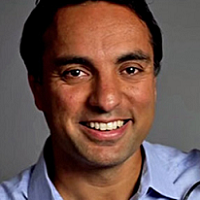 By Dr. Sonny Kohli, Co-founder and Chief Medical Officer, Cloud DX
By Dr. Sonny Kohli, Co-founder and Chief Medical Officer, Cloud DX
Twitter: @CloudDX
Moonshot thinking has inspired and disrupted healthcare delivery for decades, encouraging “anything is possible” dialogues that result in solutions to some of the world’s biggest health issues. At its core, a moonshot is a long-term, audacious goal that drives exponential change. In healthcare, there are a million moonshot ideas. Some make it, some don’t. But potential failure shouldn’t stop us from trying.
I wear two hats. I am an ICU doctor and an internal medicine doctor in Oakville, Canada. As an ICU doctor, I cannot spitball. It’s difficult for people on the clinical frontlines to be moonshot thinkers. I’m also the chief medical officer and co-founder of a healthcare technology start up called Cloud DX. As a tech startup founder, spitballing ideas is not only commonplace but considered necessary to innovate. At our startup, we’re driven by moonshot ideas.
Doctor and dreamer
My moonshot idea first began back in 2010 in Port-au-Prince, Haiti where I was volunteering with Project Medishare. The catastrophic earthquake had just struck the country. A quarter of a million people tragically died within hours of the quake and many more died in the aftermath due to lack of access to basic healthcare.
One day, a woman arrived at our hospital with chest pain. She was a smoker. Here I am, working in Haiti’s most “modern” hospital at the time, and we didn’t even have a functioning ECG machine. Fortunately, I was with two smart engineering students and together we jury-rigged a broken ECG machine to allow me to diagnose her problem. As we reflected on our work later that evening, we realized the world could really use smartphone-based, affordable diagnostic technology that leverages the cloud to make diagnosis remotely — something that could be used by anyone, anytime anywhere. And we set out to build that.
But here’s another pearl of wisdom about moonshot thinking in healthcare. A device alone doesn’t solve the problem. It’s more than that.
Communication breakdown
Even though modern mobile technology, advanced analytics and cloud-based infrastructure provide unprecedented and seamless collaboration and information sharing, redundancies, inefficiencies and communication breakdowns exist. It troubles me greatly as a physician that I cannot get access to critical information on patients I’m seeing in the emergency room. As a result, I often have to repeat testing. That costs the system money it doesn’t have. The redundancy, and disconnected and siloed information and inefficient processes also makes it easier to miss something essential that can inform my diagnosis and treatment of my patient.
Here’s an example. The new version of the Apple Watch can diagnose a very interesting arrhythmia called atrial fibrillation. Thirty percent of people over the age of 70 have it, and it’s the number one risk factor for stroke. You can treat it by modifying the risk factors and dramatically reduce your risk of stroke. But the problem is atrial fibrillation is a silent disease. If you don’t go looking for it, you won’t find it.
About a year and a half ago I was working in the ICU unit at my hospital. I saw a patient with atrial fibrillation. She had suffered a stroke and was in a very debilitated state. I sat down with her husband to talk about organ donation. Shocked and understandably heartbroken he said, “But she has a Fitbit. Is there something there we could have detected? She was fine yesterday. And now you’re telling me she’s had a debilitating stroke and she’s going to die.” I looked at the Fitbit. And there it was, staring at me in the face. Atrial fibrillation. But there was no connectivity from the device to the healthcare system that could have impacted her outcome. There’s a fundamental problem. But it’s not a technology problem. It’s a connectivity problem.
Modern Moonshot: Connected Health
I dream of a day where ubiquitous, non-invasive sensors safely and constantly monitor our health in a seamless way. Information is shared with patients, doctors, nurses and researchers enabling better diagnoses and better care. Remember the TV show, Star Trek? Dr. McCoy’s tricorder could magically diagnose your conditions. A couple of years back, my team and I at Cloud DX created a modern version of that tricorder to diagnose various conditions including atrial fibrillation. We won a XPRIZE for our idea. We proved it possible to monitor your heart, your blood pressure, your breathing, your temperature, all your body’s vital functions on a second-to-second basis and provide continuous, proactive medical grade diagnoses at home.
My moonshot for healthcare is not such a stretch. If we leverage the right mix of technology — from user-friendly medical devices and IoT sensors to powerful AI- enabled data analysis in the cloud — and that insight was shared with doctors and nurses in smart, usable ways, we can improve patient outcomes, lower costs and transform healthcare. Let’s dream big and reimagine what’s possible. Let’s catalyze that moonshot.
